PR-6171IRE Science A STEM Approach - 1st Class
Create successful ePaper yourself
Turn your PDF publications into a flip-book with our unique Google optimized e-Paper software.
Earth and the Environment<br />
IN THE SKY AND ON THE LAND<br />
Lesson 4<br />
Lesson Plan<br />
Introduction:<br />
1. Show the images of a landscape at . Discuss what a landscape<br />
is and add a definition to a word wall—’an area of land that can be viewed at one time from one<br />
place’. What season do you think it is in each picture? How do you know? How does each landscape<br />
change? In pairs, pupils write their thoughts on a mini whiteboard.<br />
Development:<br />
2. Show the video reviewing what the seasons are and then as a class,<br />
complete the simple sequencing activity. You may want to display the months and seasons on the<br />
working wall. As a class, discuss what a season is and the pattern it follows. What season are we in<br />
now? What season will come next? What was before? Does it always go in this pattern? What kind of<br />
weather do you see in each season?<br />
3. Write a class definition for season and reinforce how it is different to the weather; for example,<br />
each season has certain weather patterns, like in the winter you can expect it to be cold, rainy and<br />
cloudy.<br />
4. Watch a time-lapse video of Earth over a year, showing the changes in the landscape through the<br />
seasons . With a partner, pupils discuss the seasonal changes they<br />
viewed.<br />
5. Set up four large pieces of paper at the front of the classroom, labelled with each season. Ask<br />
pupils the following questions for each season, and instruct pupils to write or draw an answer on a<br />
sticky note and place it on the appropriate season poster for the class to see. What things do you<br />
see out on the street? What do the trees look like? What animals do you see? What colours do you<br />
see? What does the sky look like? What does the land look like? How many people do you see and<br />
what are they doing? What places do people visit? What are people wearing? What kind of weather<br />
do you see?<br />
6. Individually, pupils choose a season and a landscape they are familiar with. It could be the view<br />
out of the classroom window, a view of the playground or a view of the school street. Their task is<br />
to draw the scene and include all the things they have observed and would expect to see in that<br />
area during that season. In summer there may be lots of children wearing T-shirts in the sunshine,<br />
but in winter there may be less children because it is raining, cloudy and windy. Encourage them<br />
to capture every detail and how it changes (page 146 provides a template to draw a view from<br />
a window). Alternatively, pupils may choose one of the scenes on pages 147–148 to draw the<br />
appropriate details.<br />
Differentiation<br />
• Challenge pupils to write a few accompanying sentences for their landscape view from a<br />
window in their science books.<br />
• Some pupils can be provided with keywords associated with all seasons and choose which<br />
ones apply to their season. They use these keywords to help them with their pictures and also to<br />
complete simple sentences to describe their picture.<br />
Reflection:<br />
Viewing sample<br />
7. The artwork can be displayed around the classroom and working wall, grouped according to the<br />
seasons. Pupils can compare the landscapes and discuss any drawings that may have features that<br />
are not typical for that season or are different from the other drawings.<br />
Prim-Ed Publishing – www.prim-ed.com 978-1-912760-15-2 <strong>1st</strong> <strong>Science</strong>: 145<br />
CLASS<br />
A <strong>STEM</strong> AP<strong>PR</strong>OACH

















